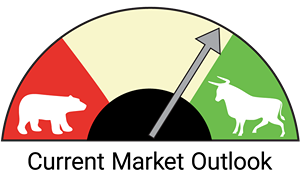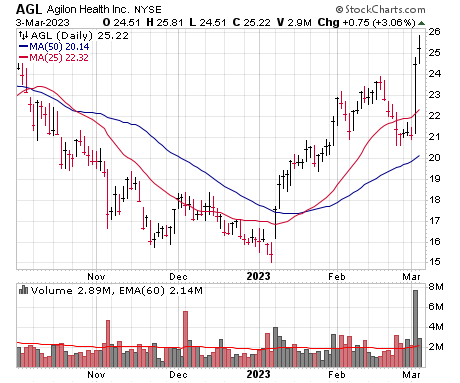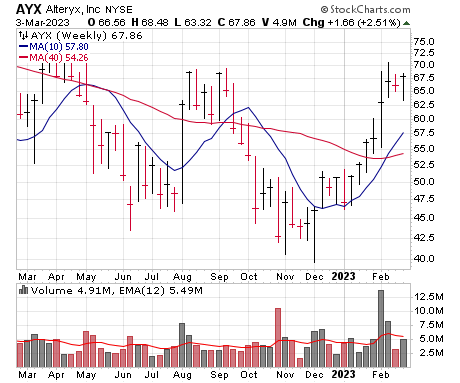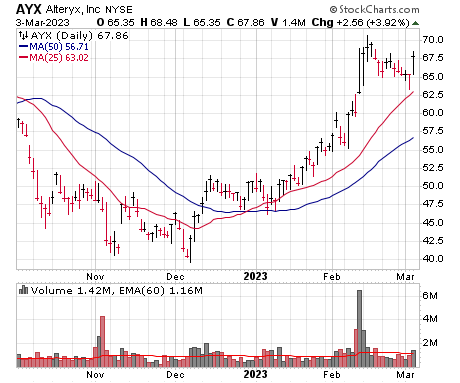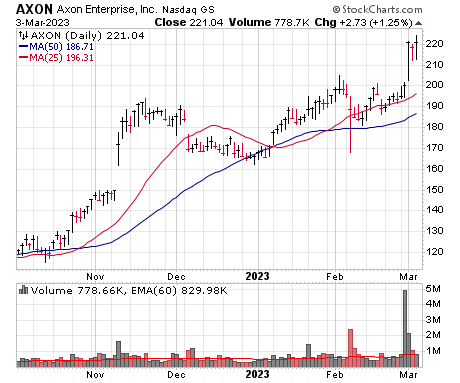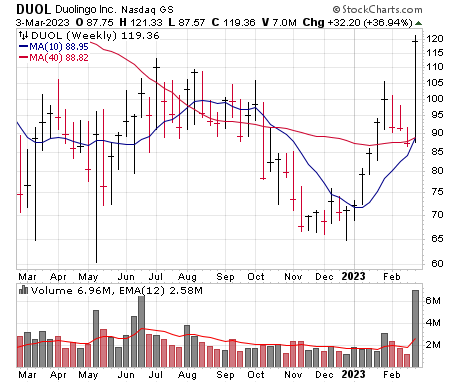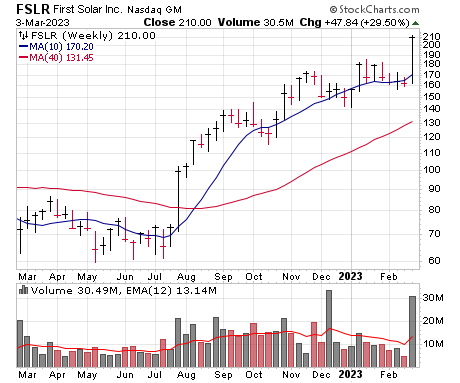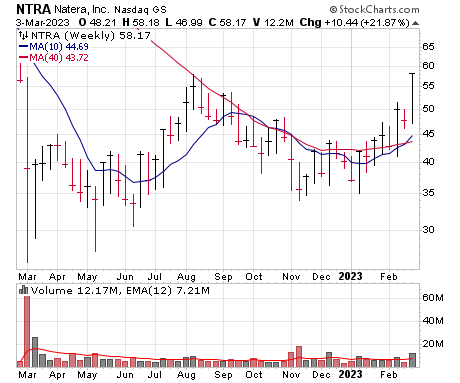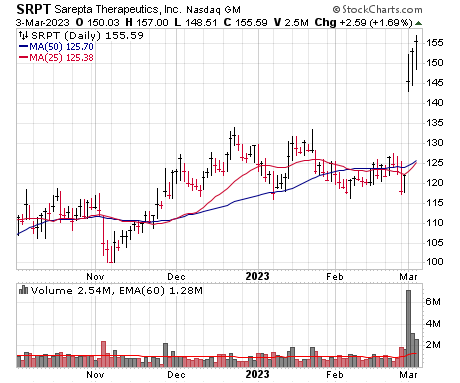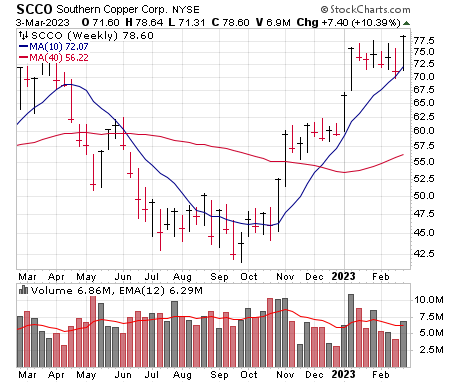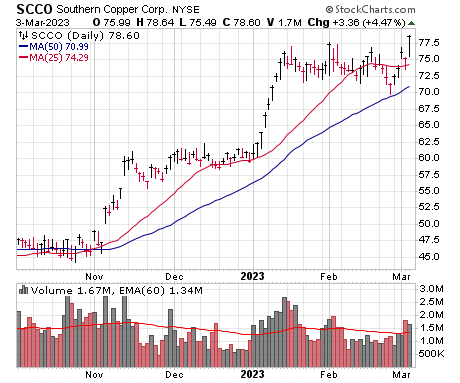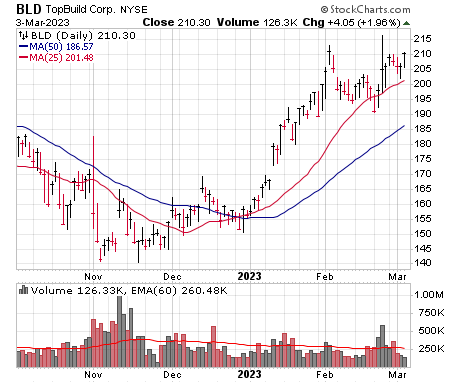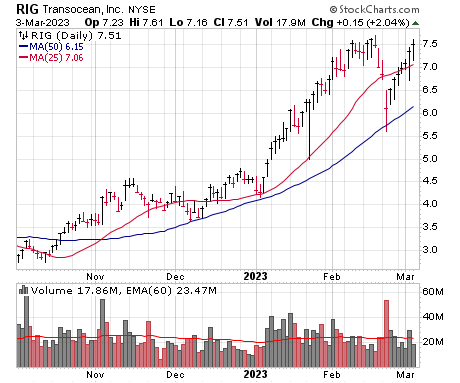More Positive than Not
We can’t say the market is out of the woods, as some major indexes still have work to do (small caps were very weak today) and a couple of bad days (the Fed Chief is speaking a couple of times this week, and the jobs report is due Friday) could be damaging. But just going with what we see, it’s hard not to be encouraged about last week’s action—after a month of pulling back, no primary indicator really flipped to negative, and among individual stocks, the vast majority retreated grudgingly before many took off on the upside in recent days. We’re not going to overreact to a day or two of action, of course, especially when a couple of bad days could make a meaningful difference, but the fact that our screens are turning up many more high-potential names has us nudging our Market Monitor back up to a level 7—though, as always, we’ll see how it goes during this week’s gauntlet of economic reports.
This week’s list is chock-full of solid growth ideas, with a smattering of cyclical exposure as well. Our Top Pick is Axon Enterprises (AXON), which dominates a big, unique market and, after three months of tests, is starting to move out of a two-year launching pad.
| Agilon Health (AGL) |
| Alteryx (AYX) |
| Axon Enterprises (AXON) ★ Top Pick ★ |
| Duolingo (DUOL) |
| First Solar (FSLR) |
| Natera (NTRA) |
| Serepta Therapeutics (SRPT) |
| Southern Copper (SCCO) |
| Topbuild (BLD) |
| Transocean (RIG) |
Stock 1
Agilon Health (AGL)
Price | Buy Range | Loss Limit |
Why the Strength
Agilon sees the number of senior citizens covered under its healthcare network growing 70% by the end of 2024, to 630,000 from 370,000 at the end of 2022. The company is one of the leaders of the value-based care movement, in which physicians have a monthly subscription-like reimbursement schedule, rather than the typical fee-per-visit model. The idea is that physicians are rewarded for focusing on the total care of a patient, encouraging preventative teamwork that reduces higher-cost outcomes like hospitalizations. The key is a federal program, Medicare Advantage, which offers a scale of improved payments to healthcare organizations in exchange for medical offices taking on some or all of the costs that exceed budgets. Agilon and its member doctors evenly split the upside (assuming they do a good job for patients, which they have been) from coordinating with Medicare, with the average primary care doctor doubling their income to nearly $400,000. It seems to work well: Agilon says its patients with diabetes, which afflicts 30% of the Medicare population, see a 19% lower total cost of care, a doubling of improvement in blood sugar and more equitable access to care than under other networks using Medicare Advantage or fee-for-service. As part of its strategy for cost control, Agilon focuses on amassing lots of doctors in each region it operates in, including southern Maine, western Tennessee, Michigan and Ohio. This year, Agilon expects new patients and markets coming on board will push revenue up 60% to around $4.34 billion. It doesn’t make profits yet (the six-year-old business lost 26 cents a share in 2022) but broadening margins show Agilon is headed in the right direction, with the average medical margin on its Medicare Advantage patient up 67% last year. It’s a metric that focuses on income and costs directly related to patient care, and should rise as Agilon’s network expands.
Technical Analysis
AGL was nailed in the latter part of 2021 and into early 2022, but interestingly, the stock actually bottomed more than a year ago (January 2022), with the following two big selling waves (into May and again in December) finding support at slightly higher levels. AGL got off to a great start this year, but it was last week’s action that was noticeable, with shares catapulting higher on Thursday and Friday after earnings. We like the action, though there is some overhead to chew through, so we’ll set our range down a little from here.
| Market Cap | $10.4B | EPS $ Annual (Dec) | ||
| Forward P/E | N/A | FY 2021 | -1.05 | |
| Current P/E | N/A | FY 2022 | -0.26 | |
| Annual Revenue | $2.71B | FY 2023e | -0.09 | |
| Profit Margin | 0.1% | FY 2024e | 0.21 | |
| Qtrly Rev | Qtrly Rev Growth | Qtrly EPS | Qtrly EPS Growth | |
| ($M) | (vs. yr-ago-qtr) | ($) | (vs. yr-ago-qtr) | |
| Latest qtr | 690 | 49% | -0.14 | N/A |
| One qtr ago | 695 | 52% | -0.07 | N/A |
| Two qtrs ago | 670 | 34% | -0.05 | N/A |
| Three qtrs ago | 654 | 58% | 0.01 | N/A |
Weekly Chart | Daily Chart |
Stock 2
Alteryx (AYX)
Price | Buy Range | Loss Limit |
Why the Strength
The accelerating growth of machine learning and automated devices is a huge part of the big data industry, which is expected to grow at a compound annual rate of 20% over the next four years. Software provider Alteryx is a leader in the big data field with a platform that allows users to acquire, blend and analyze business data from diverse sources. Its cloud-based software delivers machine learning and end-to-end automation of analytics, making it easier for clients to generate sales-related insights and discover revenue opportunities, as opposed to just having reams of data thrown into their laps. In the last couple of years, Alteryx has shifted its focus from selling its software to individual users (mainly business analysts) to large organizations, while also expanding its partnerships with tech giants like Google, Snowflake and Amazon as part of a drive to increase its enterprise user base. The transition has paid off handsomely in the last several quarters, most recently in Q4 when Alteryx reported an eye-popping 73% revenue increase from a year ago, while per-share earnings of 84 cents were equally impressive, beating estimates by 33 cents and rising nearly five-fold from the year-ago quarter. Alteryx ended Q4 with annual recurring revenue (ARR) of $834 million (up 31%), while increasing its sales of additional products with existing customers by 21%. The company also finished with nearly 8,400 customers (up 5%), including over 140 clients with over $1 million in ARR. Alteryx said it’s seeing “robust demand” for data analytics after selling more enterprise licenses in Q4 than the rest of the year combined (which is especially impressive given the IT spending cutbacks being seen elsewhere). Additionally, the top brass guided for midpoint sales of $200 million for Q1 (up 27% if realized) and expects full-year ARR to increase by a healthy 23% while earnings take off. It’s a solid story.
Technical Analysis
AYX was a leader from 2017-2020, but then business was crimped and the stock fell off a cliff, dropping from a peak near 180 to lows in the 40 to 50 range in last year’s bear. Interestingly, while the best stocks generally bottomed in the spring or summer, AYX’s nadir wasn’t until December, but it’s really impressed since then, rising 11 of the past 14 weeks, including an earnings-induced spike on its heaviest weekly volume in two years. The recent rest looks normal to us—we’re OK nibbling here and adding on a breakout north of 72 or so.
| Market Cap | $4.70B | EPS $ Annual (Dec) | ||
| Forward P/E | 170 | FY 2021 | -0.12 | |
| Current P/E | N/A | FY 2022 | 0.02 | |
| Annual Revenue | $856M | FY 2023e | 0.40 | |
| Profit Margin | 21.3% | FY 2024e | 0.74 | |
| Qtrly Rev | Qtrly Rev Growth | Qtrly EPS | Qtrly EPS Growth | |
| ($M) | (vs. yr-ago-qtr) | ($) | (vs. yr-ago-qtr) | |
| Latest qtr | 301 | 73% | 0.84 | 367% |
| One qtr ago | 216 | 75% | -0.05 | N/A |
| Two qtrs ago | 181 | 50% | -0.46 | N/A |
| Three qtrs ago | 158 | 33% | -0.40 | N/A |
Weekly Chart | Daily Chart |
Stock 3
Axon Enterprises (AXON) ★ Top Pick ★
Price | Buy Range | Loss Limit |
Why the Strength
With all the economic uncertainties out there, Axon offers an escape from that, with a growth story that seems set to continue for many years as it pioneers various offerings that help law enforcement agencies do things safer and more efficiently. It starts with its less-lethal Tasers, which continue to see more and more adoption both in the U.S. and overseas; management is very high on the latest release (Taser 10, out in late January), which offers far more range (45 feet vs 25 feet) and more probes (effectively more shots at the target), as well as some other safety features (pulsating lights). When combined with training and other tools, something like two-thirds of Tasers actually sell on recurring payment plans. And that fits nicely with all the newer products, including body and car cameras, Evidence.com (a cloud management platform for video evidence), cloud dispatch software, drones and more, which are penetrating a gigantic market and leading to ever-increasing amounts of recurring future revenue. Indeed, in the just-reported Q4, sales and earnings both rose nicely (just over 50%), but it was the 45% leap in annualized recurring revenue and the 66% gain in contracted future revenue that were the real draw (figures that rise every quarter). By 2025, Axon aims to have north of $2 billion of annual revenue (up 20%-ish percent annually), with EBITDA growing nearly 30% per year and strong free cash flow, too. To be fair, the valuation is up there (expectations are high), but if the top brass executes, there shouldn’t be much in the way of strong growth for a long time to come. Analysts see earnings up 30%-plus this year and next.
Technical Analysis
AXON has been building a giant launching pad for the past two years, and when that happens, the last many weeks usually end up being a base within itself. That’s just what we saw from AXON since it raced up to 190 or so near Thanksgiving, with three months of reasonable ups and downs, including a shakeout four weeks ago. And then came the liftoff last week, with a huge-volume breakout above 200. It could wiggle around a bit, but we’re OK buying some around here.
| Market Cap | $16.1B | EPS $ Annual (Dec) | ||
| Forward P/E | 78 | FY 2021 | 2.35 | |
| Current P/E | 100 | FY 2022 | 2.19 | |
| Annual Revenue | $1.19B | FY 2023e | 2.84 | |
| Profit Margin | 15.2% | FY 2024e | 3.76 | |
| Qtrly Rev | Qtrly Rev Growth | Qtrly EPS | Qtrly EPS Growth | |
| ($M) | (vs. yr-ago-qtr) | ($) | (vs. yr-ago-qtr) | |
| Latest qtr | 336 | 54% | 0.70 | 52% |
| One qtr ago | 312 | 34% | 0.60 | -49% |
| Two qtrs ago | 286 | 31% | 0.44 | 16% |
| Three qtrs ago | 256 | 31% | 0.45 | 45% |
Weekly Chart | Daily Chart |
Stock 4
Duolingo (DUOL)
Price | Buy Range | Loss Limit |
Why the Strength
We’ve been keeping a distant eye on Duolingo for many months now, as the growth story seemed unique and strong—and now, the stock is finally starting to change character. The firm bills itself as the top mobile leaning platform, though most of that is about languages right now; it has the top-grossing education app in the Apple and Google app stores. The firm uses a freemium model, with 60.7 million total users (up 43%; these users do see ads), though it’s the 4.2 million paying subscribers (up 67%) that make up most of revenue. (The paid percentage has been increasing, from 6.2% a year ago to 7.8% now.) The platform is fun (there are even quests that encourage users to complete tasks) and constantly evolving, with AI allowing users to learn through conversations and explanations (so users understand what they did wrong) likely to be a big help. The offering is so popular that it’s being adopted by thousands of higher-education places to run English acceptance tests, too. Growth has been solid for a while, with subscription revenue up 53% in Q4 and making up three-quarters of revenue, with advertising (up 16% last year) and English tests (up 33%) making up most of the rest. And while the bottom line is in the red, free cash flow is in the black (a little over $1 per share in 2022), and the top brass is bullish on 2023, expecting mid-30% revenue growth (likely conservative) and EBITDA margins to expand. All in all, Duolingo is the leading player in a big market, which should lead to excellent growth over time.
Technical Analysis
DUOL came public in late 2021, popped for a bit and then was crushed with the bear market, falling from around 200 to 60 in about nine months. That was the low, however, with a decent summer rally petering out, leading to a higher low near year-end. DUOL did rally six weeks in a row from there (a subtle sign of persistent accumulation), and after a three-week dip, it came alive last week, with the stock tagging 15-month highs on record weekly volume and following through to higher prices today. Shares are a bit thinly traded, so we’ll set our entry range down a few points.
| Market Cap | $4.80B | EPS $ Annual (Dec) | ||
| Forward P/E | N/A | FY 2021 | -1.63 | |
| Current P/E | N/A | FY 2022 | -1.51 | |
| Annual Revenue | $370M | FY 2023e | -0.88 | |
| Profit Margin | N/A | FY 2024e | -0.34 | |
| Qtrly Rev | Qtrly Rev Growth | Qtrly EPS | Qtrly EPS Growth | |
| ($M) | (vs. yr-ago-qtr) | ($) | (vs. yr-ago-qtr) | |
| Latest qtr | 104 | 42% | -0.35 | N/A |
| One qtr ago | 96.1 | 51% | -0.46 | N/A |
| Two qtrs ago | 88.4 | 50% | -0.38 | N/A |
| Three qtrs ago | 81.2 | 47% | -0.31 | N/A |
Weekly Chart | Daily Chart |
Stock 5
First Solar (FSLR)
Price | Buy Range | Loss Limit |
Why the Strength
A U.S. ban on goods made from forced labor in China, along with other trade policies, put a crimp in the domestic solar industry last year. Utility-scale solar installations fell by 23%, as most solar system components are from China and many were blocked by U.S. customs from entering the country, effectively jamming the solar supply chain. First Solar, a leading thin-film solar panel and advanced utility-scale photovoltaic solutions provider, has deftly avoided these problems, thanks to a strong domestic manufacturing and supply chain. Even better is the surge in demand seen for the firm’s wares in the wake of the green energy bill passed by Congress last year. The company hit several high notes in Q4, including reaching the $1 billion revenue mark for the first time since before the pandemic—a 10% improvement from a year ago and up a whopping 67% from Q3. And while a seven-cent EPS loss was reported, it still beat estimates by eight cents and narrowed considerably from the previous three quarters. Really, though, this is all about First Solar’s bullish future: For full-year 2022, First Solar logged over 48 gigawatts (GW) of net bookings—nearly triple the prior year’s level—with management saying they’re basically sold out through 2025, and it’s now taking orders for 2026 and even into 2029! The stellar news prompted a major Wall Street bank to upgrade its share guidance, which acknowledged the “high demand for its domestic capacity” (another reason for the stock’s strength). Going forward, First Solar aims to double its production capacity over the next two years with plans to open a 3.3 GW factory in Ohio later this year, followed by another development facility next year, then another factory in Alabama in 2025, which will bring its total U.S. capacity to around 10 GW. Management also guided for full-year EPS of around $7.50 (miles above the year-ago level and 35% above analyst estimates) and revenue of $3.5 billion (up 34% if realized)—and 2024 should be even more bullish.
Technical Analysis
Solar stocks took off after the green energy bill last summer and had a good run, but in recent months the group has been mixed, with many stocks stagnating and others losing their luster. But FSLR has been the liquid leader of the sector, with the stock notching higher highs and higher lows since September of last year—an “ascending base” of sorts over many months. And now the buyers are back at it, with the Q4 report causing a huge-volume breakout. It’s not in the first inning of its run, but we’re OK grabbing some shares on minor weakness.
| Market Cap | $22.4B | EPS $ Annual (Dec) | ||
| Forward P/E | 33 | FY 2021 | 4.38 | |
| Current P/E | N/A | FY 2022 | -0.41 | |
| Annual Revenue | $2.62B | FY 2023e | 6.33 | |
| Profit Margin | N/A | FY 2024e | 12.43 | |
| Qtrly Rev | Qtrly Rev Growth | Qtrly EPS | Qtrly EPS Growth | |
| ($M) | (vs. yr-ago-qtr) | ($) | (vs. yr-ago-qtr) | |
| Latest qtr | 1002 | 10% | -0.07 | N/A |
| One qtr ago | 629 | 8% | -0.46 | N/A |
| Two qtrs ago | 621 | -1% | 0.52 | -32% |
| Three qtrs ago | 367 | -54% | -0.41 | N/A |
Weekly Chart | Daily Chart |
Stock 6
Natera (NTRA)
Price | Buy Range | Loss Limit |
Why the Strength
Natera has built a fast-growing business out of screening cell-free DNA (cfDNA) fragments in the bloodstream for diseases. A simple blood draw captures cfDNA and, in some cases, just one molecule is enough for Natera to identify afflictions. The company established itself through a widely used prenatal test, Panorama, which is a noninvasive way of screening for a variety of fetal problems simply by taking a vial of the mother’s blood. Investors also see lots of growth ahead for other screens, including Signatera, a colorectal cancer test that the company estimated was ordered by 30% of oncologists last quarter. All of that combined produced revenue growth of 28% in 2022, to $820 million, and momentum should push sales toward $1 billion this year. And there should be plenty more offerings to come: The company recently received approval by Medicare for Signatera to screen for breast cancer, meaning that test will be used more and also get reimbursed at a higher price by the government. (Medicare coverage is vitally important to the business, accounting for the majority of annual revenue.) Breast cancer screens, along with some other predictive tests that are promising, could expand the market for Natura tests by more than a million units in the near future; by comparison, Natera processed 2.1 million screens last year. As established tests scale up, the business should be able to ease spending. Reducing the cash burn will lift some weight off shares, given the net loss has been over $5 a diluted share each of the past two years. Genetic blood screens hold lots of potential for other situations too; Natura has another test, Prospera, which determines odds of kidney, lung and heart transplant rejection. It’s early stages for that test, but trial results are positive.
Technical Analysis
NTRA is reversing a 14-month downtrend as investors rallied shares on news mid-February of Medicare coverage of Signatera for breast cancer screening. A bullish quarterly report a week ago reinforced the positive sentiment, with shares leaping on three straight days of strong volume and even nosing above resistance at 57—all of which looks to be part of a multi-month bottoming effort. We think dips of a couple of points would be tempting.
| Market Cap | $6.32B | EPS $ Annual (Sep) | ||
| Forward P/E | N/A | FY 2021 | -5.21 | |
| Current P/E | N/A | FY 2022 | -5.57 | |
| Annual Revenue | $820M | FY 2023e | -4.14 | |
| Profit Margin | N/A | FY 2024e | -2.91 | |
| Qtrly Rev | Qtrly Rev Growth | Qtrly EPS | Qtrly EPS Growth | |
| ($M) | (vs. yr-ago-qtr) | ($) | (vs. yr-ago-qtr) | |
| Latest qtr | 217 | 26% | -1.37 | N/A |
| One qtr ago | 211 | 33% | -1.25 | N/A |
| Two qtrs ago | 198 | 40% | -1.50 | N/A |
| Three qtrs ago | 194 | 27% | -1.45 | N/A |
Weekly Chart | Daily Chart |
Stock 7
Sarepta Therapeutics (SRPT)
Price | Buy Range | Loss Limit |
Why the Strength
Sarepta (covered in the December 19 report) is a biotech focused on leveraging RNA technology and gene editing to treat rare diseases caused by a single genetic mutation. Most of its therapies are indicated for Duchene Muscular Dystrophy (DMD), a neuromuscular disease that occurs in one in every 3,500 to 5,000 males worldwide, often leads to early life in a wheelchair and cuts lifespans short. Three of its RNA therapies for DMD are commercialized and selling well, while a fourth is in the clinical stage of development. The pipeline also boasts eight gene therapy candidates for DMD and another muscular dystrophy disease in various stages of development, plus two preclinical gene editing candidates for DMD. The stock is strong today, though, because of that fourth DMD treatment that could be a blockbuster: SRPT-9001 has been granted a priority regulatory review, with a decision scheduled for May 29; the FDA said it wouldn’t hold an advisory committee meeting on the drug’s marketing application, which most interpret to mean it should be good to go with its current clinical trial data. The company believes SRP-9001 could eventually bring in $4 billion of annual sales (partly by broadening the number of DMD patients able to be treated), inducing a major Wall Street bank to upgrade the shares (big reasons for the strength). Last week’s earnings report served as an additional catalyst for the stock’s strength, as Sarepta’s Q4 revenue of $258 million beat estimates and increased 28% from a year ago, while full-year sales of $844 million increased a solid 38%. However, the firm also reported a per-share loss of $1.24 that missed estimates by five cents (although the loss shrunk significantly from Q3). Other Q4 highlights included Sarepta initiating a clinical study of SRP-9003 for the treatment of LGMD Type 2E, and an expanded strategic partnership with Catalent to manufacture SRP-9001. For 2023, Wall Street sees 34% sales growth, while analysts see the bottom line kicking into gear in 2024 as SRPT-9001 penetrates the market.
Technical Analysis
SRPT crashed in early 2021 on some FDA issues with SRPT-9001, and it really didn’t get off its knees much during the next couple of years, falling to 60 three times last year. However, shares changed character last June, racing up to the 120 area in the fall, and then began to etch what morphed into a base-on-base formation, with five months of no net progress. Last week was the coming out party, of course, with SRPT blasting ahead on its heaviest volume since that early 2021 meltdown. We’ll see our buy range down a bit, thinking shares could wiggle a bit near term.
| Market Cap | $13.7B | EPS $ Annual (Dec) | ||
| Forward P/E | N/A | FY 2021 | -3.80 | |
| Current P/E | N/A | FY 2022 | -3.06 | |
| Annual Revenue | $933M | FY 2023e | -5.13 | |
| Profit Margin | N/A | FY 2024e | 5.04 | |
| Qtrly Rev | Qtrly Rev Growth | Qtrly EPS | Qtrly EPS Growth | |
| ($M) | (vs. yr-ago-qtr) | ($) | (vs. yr-ago-qtr) | |
| Latest qtr | 258 | 28% | -0.53 | N/A |
| One qtr ago | 230 | 22% | -0.80 | N/A |
| Two qtrs ago | 234 | 42% | -1.18 | N/A |
| Three qtrs ago | 211 | 43% | -0.56 | N/A |
Weekly Chart | Daily Chart |
Stock 8
Southern Copper (SCCO)
Price | Buy Range | Loss Limit |
Why the Strength
Chinese manufacturing activity is ramping up following last year’s super-strict Covid-related shutdowns, which is boosting demand for all sorts of key commodities, including copper. China’s factory activity in February reached its highest level since 2012, which is a big deal given that the country is the largest consumer of the metal. Standing to benefit from this trend is Phoenix-based Southern Copper (covered in the January 30 report), a leading miner, smelter and refiner of several industrial and precious metals; it boasts the highest copper reserves of any listed company and is the world’s fifth-largest producer of the metal. Last month, the company reported that its copper production in Q4 was slightly higher from Q3, but said its mines were running at full capacity despite political protests in Peru (the world’s number two supplier) that forced many copper miners to shutter operations. Revenue of $2.8 billion was unchanged from a year ago but beat estimates by 14%, while per-share earnings of $1.17 topped the consensus by 41%. Sales volumes increased 2% for copper, 6% for silver and 38% for zinc (but fell 16% for molybdenum). Mined silver output, meanwhile, jumped 10% while the Q4 operating cash cost of copper mining fell 40% from a year ago. Looking ahead, management said copper market fundamentals are “solid” and expects inventories to remain very tight this year (about three days of consumption), with global demand conservatively estimated to grow 3%. Southern Copper also sees China’s reopening and renewable energy demand as additional positives and remains focused on expansion, with plans to deliver 35,000 tons of copper from its Pilares mine in Mexico in 2023. Wall Street sees flattish sales and earnings this year but that could easily prove conservative given China’s faster-than-expected recovery.
Technical Analysis
After a run-up early in the year, SCCO took it on the chin last April, falling from a peak near 80 to 45 by mid-July. Fifteen weeks of tight basing followed, which set the stage for the cup-shaped recovery of the last four months. A shakeout attempt in late February was stopped at the 50-day line and the stock is now almost back to all-time highs. There’s a bit of supply to chew through in this area, but we think the path of least resistance is up. We’re fine nibbling here or on pullbacks.
| Market Cap | $60.8B | EPS $ Annual (Dec) | ||
| Forward P/E | 23 | FY 2021 | 4.39 | |
| Current P/E | 22 | FY 2022 | 3.41 | |
| Annual Revenue | $10.1B | FY 2023e | 3.39 | |
| Profit Margin | 32.0% | FY 2024e | 4.17 | |
| Qtrly Rev | Qtrly Rev Growth | Qtrly EPS | Qtrly EPS Growth | |
| ($B) | (vs. yr-ago-qtr) | ($) | (vs. yr-ago-qtr) | |
| Latest qtr | 2.82 | 0% | 1.17 | 8% |
| One qtr ago | 2.16 | -20% | 0.67 | -40% |
| Two qtrs ago | 2.31 | -20% | 0.56 | -54% |
| Three qtrs ago | 2.76 | 9% | 1.02 | 3% |
Weekly Chart | Daily Chart |
Stock 9
TopBuild (BLD)
Price | Buy Range | Loss Limit |
Why the Strength
Despite an underwhelming residential construction market, the need for thermal insulation is as strong as ever, thanks largely to the increasing demand for energy-efficient housing and commercial buildings. TopBuild is a leader in this space and provides insulation installation and related building materials for the residential, commercial and industrial end-markets in the U.S. and Canada. The firm’s Q4 report featured record top- and bottom-lines as it outperformed in all three of its end markets. A testament to this was the 44% sales increase for 2022 (to $5 billion); moreover, in the last four years, revenue has grown at a compound annual rate of 20%. Sales for Q4 were $1.3 billion (up 19%) as installation volume grew 12%, while per-share earnings of $4.40 beat estimates by 10% and adjusted EBITDA margin expanded in a big way. The company believes its operating model allows it to outperform in any environment, and management said it’s focused on acquiring quality installation and specialty distribution companies that fit within TopBuild’s core insulation businesses. On that front, the company just purchased residential insulation installer SRI Holdings and completed five strategic residential-heavy acquisitions last year. Of course, the housing market will have an impact in the quarters ahead; for 2023, the company guided for sales of $4.8 billion and analysts see earnings down a touch, but that’s far better than expected just a few months ago thanks to a strong backlog of single and multifamily homes and commercial buildings that need to be insulated. The top brass also expects Q1 earnings to increase 15% and said it sees “multiple avenues of growth” available longer term with an addressable market of $16 billion, of which the company currently has a 20% market share.
Technical Analysis
Like the rest of the construction sector, BLD had a good couple of years before rising rates took their toll, with the peak in late 2021 leading to shares basically getting cut in half over a 12-month period before coming to rest at 140 last November. The bottom-building effort was brief, and BLD has come to life this year, moving above its 40-week line in January and continuing higher after earnings two weeks ago. We think the stock is a decent risk/reward around here.
| Market Cap | $6.67B | EPS $ Annual (Dec) | ||
| Forward P/E | 13 | FY 2021 | 10.85 | |
| Current P/E | 12 | FY 2022 | 17.11 | |
| Annual Revenue | $5.00B | FY 2023e | 15.61 | |
| Profit Margin | 11.1% | FY 2024e | 16.40 | |
| Qtrly Rev | Qtrly Rev Growth | Qtrly EPS | Qtrly EPS Growth | |
| ($B) | (vs. yr-ago-qtr) | ($) | 64 | |
| Latest qtr | 1.26 | 19% | 4.40 | 41% |
| One qtr ago | 1.30 | 54% | 4.80 | 63% |
| Two qtrs ago | 1.27 | 53% | 4.43 | 61% |
| Three qtrs ago | 1.17 | 57% | 3.50 | 73% |
Weekly Chart | Daily Chart |
Stock 10
Transocean (RIG)
Price | Buy Range | Loss Limit |
Why the Strength
Deepwater offshore drillers were all basically wiped away during the oil bust in recent years, but today there are many factors helping out. The first is the bust itself—operators have mothballed many rigs and cut costs to the bone, often after Chapter 11 filings (though Transocean was one of the few that didn’t go under). The second factor is resilient oil prices, which have remained north of $70 (now near $80) despite the Fed being on the warpath and economic worries. And third is the under-investment in the energy sector as a whole, which has big majors embarking on drilling plans that don’t change with every $5 or $10 hiccup in oil prices. Transocean is one of the granddaddies of the group, with 39 rigs (all of which are ultra-deepwater or harsh environment); 25 of those are on the water today, with another two being built (including one that’s part of a joint venture)—in the firm’s words, it has the largest and highest specification fleet of floaters in the world. It also still has 12 rigs mothballed, but that may be changing as dayrates rise and as many offshore projects are set to go live in the next year and a half. There’s plenty of liquidity here, and while shaping up the balance sheet remains a priority, the past couple of quarters seem to have brought a sea change in multi-year order flow: After adding just $300 million or so to its backlog in Q1 and Q2, Q3 added $1.74 billion and Q4 added another $1.56 billion, with more so far this year—as of February 9, Transocean sported an $8.5 billion backlog, up from $7.3 billion and $6.2 billion three and six months prior (respectively). Meanwhile, while the bottom line is in the red, EBITDA is perking up ($140 million in Q4) and has a chance to really soar as dayrates rise and most of the increased revenue falls to the bottom line. It’s an interesting turnaround situation.
Technical Analysis
RIG was held below 5 for most of 2021 and all of 2022, with drops into the low- to mid-2s happening as the bear wore on. But the stock has been a totally different animal since last September, rebounding above 4, basing for a few weeks and then breaking out in mid-January and going nuts on the upside. The post-earnings action was ugly, but it looks like a shakeout now, with the 10-week line offering support. We’ll set our buy range down a few dimes, thinking another wobble or two is possible. FYI, keep position sizes small and use a loose stop given the volatility.
| Market Cap | $5.45B | EPS $ Annual (Dec) | ||
| Forward P/E | N/A | FY 2021 | -0.74 | |
| Current P/E | N/A | FY 2022 | -0.93 | |
| Annual Revenue | $2.58B | FY 2023e | -0.35 | |
| Profit Margin | N/A | FY 2024e | 0.32 | |
| Qtrly Rev | Qtrly Rev Growth | Qtrly EPS | Qtrly EPS Growth | |
| ($M) | (vs. yr-ago-qtr) | ($) | (vs. yr-ago-qtr) | |
| Latest qtr | 606 | -2% | -0.49 | N/A |
| One qtr ago | 691 | 10% | -0.06 | N/A |
| Two qtrs ago | 692 | 5% | -0.10 | N/A |
| Three qtrs ago | 586 | -10% | -0.28 | N/A |
Weekly Chart | Daily Chart |
Previously Recommended Stocks
| Date | Stock | Symbol | Top Pick | Original Buy Range | 3/6/23 |
| HOLD | |||||
| 9/12/22 | ★ | 48.5-51.5 | 59 | ||
| 2/21/23 | 123-127 | 126 | |||
| 2/13/23 | ★ | 40.5-42.5 | 45 | ||
| 2/21/23 | 49.5-50.5 | 49 | |||
| 1/30/23 | 89-91 | 96 | |||
| 2/21/23 | ★ | 140-144 | 139 | ||
| 2/27/23 | Axcelis Technologies | ACLS | ★ | 116-122 | 128 |
| 2/21/23 | 26-27 | 26 | |||
| 2/27/23 | Cirrus Logic | CRUS | 99-103 | 103 | |
| 2/21/23 | 418-428 | 426 | |||
| 2/6/23 | ★ | 44-45.5 | 43 | ||
| 11/7/22 | 145-150 | 203 | |||
| 2/6/23 | 218-228 | 227 | |||
| 2/21/23 | 68.5-71 | 73 | |||
| 1/17/23 | 102-105 | 123 | |||
| 1/23/23 | 247-254 | 266 | |||
| 1/17/23 | 74.5-77 | 85 | |||
| 1/3/23 | 31.5-33.5 | 41 | |||
| 2/13/23 | 73.5-75.5 | 75 | |||
| 2/27/23 | Nvidia | NVDA | 225-230 | 236 | |
| 2/6/23 | 352-362 | 353 | |||
| 1/9/23 | ★ | 218-226 | 255 | ||
| 2/13/23 | 113-118 | 123 | |||
| 2/6/23 | 54.5-56.5 | 55 | |||
| 2/13/23 | 42-44 | 45 | |||
| 2/21/23 | 31.5-34 | 33 | |||
| 2/13/23 | 67-70 | 74 | |||
| 11/21/22 | 44-46 | 71 | |||
| 1/30/23 | 71-73.5 | 77 | |||
| 1/30/23 | 114-117 | 132 | |||
| 2/27/23 | Super Micro Computer | SMCI | 94-97 | 98 | |
| 2/21/23 | 33-34.5 | 34 | |||
| 1/23/23 | 47.5-50 | 52 | |||
| 2/27/23 | Wesco | WCC | 161-166 | 171 | |
| 8/22/22 | 115-120 | 173 | |||
| 12/5/22 | Wynn Resorts | WYNN | 81-84 | 116 | |
| WAIT | |||||
| 2/27/23 | 38-40 | 43 | |||
| 2/27/23 | 159-163 | 166 | |||
| 2/27/23 | 180-185 | 188 | |||
| 2/27/23 | Uniited Rentals | URI | 442-455 | 476 | |
| SELL RECOMMENDATIONS | |||||
| 1/30/23 | 632-655 | 622 | |||
| 2/6/23 | 32.5-33.5 | 28 | |||
| 2/13/23 | 295-304 | 291 | |||
| 1/9/23 | 211-215 | 257 | |||
| 2/13/23 | 68-70 | 63 | |||
| 2/6/23 | 42.5-44.5 | 45 | |||
| 1/30/23 | 21.2-22.2 | 23 | |||
| 1/23/23 | Toll Brothers | TOL | 53-55 | 59 | |
| DROPPED | |||||
| 2/21/23 | 74.5-76.5 | 87 | |||
| 2/21/23 | 60-62 | 66 | |||
The next Cabot Top Ten Trader issue will be published on March 13, 2023.

